How important are online customer reviews to shoppers? Very important, as it turns out. The fact is that 90% of consumers read online reviews before visiting a business. And 88% of consumers trust online reviews as much as personal recommendations.
Let’s say you’re craving sushi and find two restaurants nearby. One has dozens of glowing five-star reviews, customers raving about the melt-in-your-mouth salmon and impeccable service.
The other? Barely any reviews, just a couple of vague comments. Which one are you choosing?
Exactly.
Online reviews have become the new word-of-mouth—except now, they’re permanent, searchable, and influence thousands of decisions daily. Whether you’re a local business or a global brand, what customers say about you online can shape your success more than any ad campaign ever could.
In this article, we’ll explore why online reviews matter and, more importantly, share unique, tried-and-tested tips from real businesses.
Stick around until the end. There’s also a powerful infographic packed with the latest online review stats and trends to help you with your brand strategy.
Why are Online Reviews Important? How Online Reviews Shape Sales & Brand Perception
Would you eat at a restaurant with a 2-star rating?
Chances are, you’d think twice and even thrice. But if it had a 4.5-star rating and hundreds of glowing reviews, you’d probably book a table immediately.
That’s the power of online customer reviews in action. They shape our perception of an establishment and build trust, ultimately driving sales.
Much like how people used to rely on word-of-mouth recommendations from friends and family, consumers now turn to online reviews.
And numbers back the fact that positive online reviews drive revenue.
Conversion rate and revenue lift:
When customers see positive reviews, they gain confidence, leading to action. Here’s how engaging with reviews can boost your conversion rates and revenue.
- Responding to reviews can increase conversion rates by 144%
Engaging with reviews can increase conversion rates by 144% and revenue per visitor by 162%.
Interacting with customer reviews—whether positive or negative—shows potential buyers that your brand is active, trustworthy, and values customer feedback.
Pro tip: Set up a system to respond to reviews within 24-48 hours. A simple “Thank you for your feedback!” or addressing concerns directly can make a huge impact.
- A well-placed review section on a product page can triple conversion rates.
Reviews on product pages can increase conversion rates by up to 3.5 times and revenue per visitor by 4.5 times.
Shoppers browsing online often hesitate before clicking “Buy,” but honest customer feedback helps them make confident decisions.
Pro tip: Highlight top reviews on your homepage, emails, and ads. Seeing other customers’ positive experiences builds instant trust and encourages bigger purchases.
Take Anthropologie, for example. The fashion brand makes reviews impossible to miss by featuring star ratings at the top of product pages—instantly pulling shoppers in.
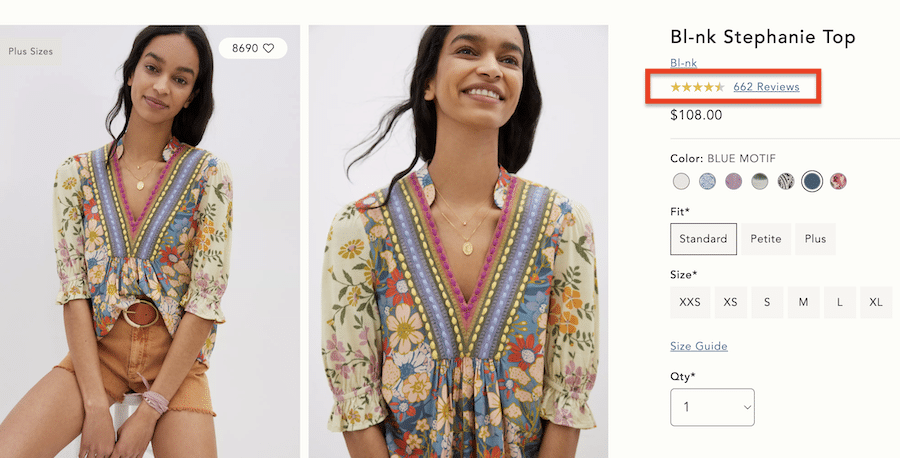
As you scroll, you’ll see real customer feedback, from fit and fabric quality to styling tips and photos.
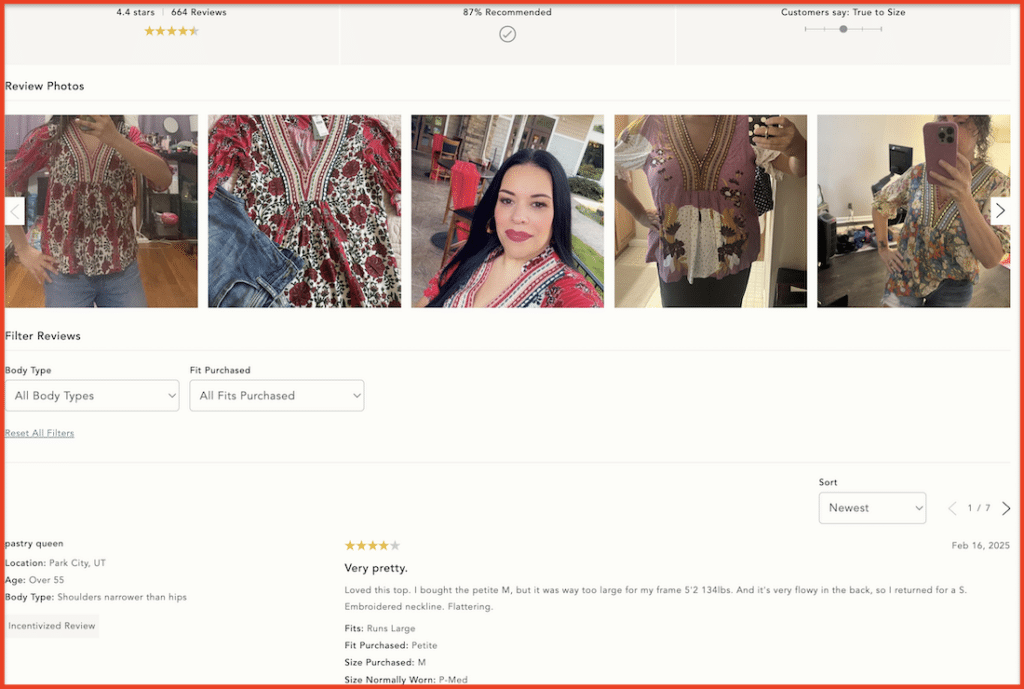
This helps visitors shop more confidently, posing Anthropologie as a go-to shopping destination. When buyers know precisely what to expect, they keep coming back.
- More reviews, more sales: why five is the magic number
If you’re selling a product online, the difference between zero and five reviews is massive. Research shows that products with at least five quality reviews have a 270% higher chance of being purchased than those with none.
The reason is simple. Shoppers want reassurance, and while a single five-star review might seem planted, five or more reviews create trust and credibility. They show that real people have tried the product and found it worth buying.
Pro tip: Encourage early customers to leave reviews. Offer a small incentive, follow up with a friendly email, or make it super easy to leave feedback.
SEO benefits of customer reviews:
Beyond customer feedback, customer reviews also help you elevate your website’s search engine optimization (SEO) and rankings.
Here’s how online customer reviews help you rank higher in search engines and enhance SEO:
- Online reviews serve as fresh, user-generated content
Search engines like Google prioritize fresh and relevant content.
Each customer review adds unique, user-generated content to your site, signaling to search engines that your business is active and engaged with its customers. This continuous influx of content can lead to improved search rankings.
Pro tip: Encourage customers to leave reviews by sending follow-up emails after a purchase or offering small incentives.
- Online reviews work well for keyword integration
Customers often use natural language in their reviews, incorporating keywords that potential customers might use when searching for products or services like yours. This organic inclusion of keywords can enhance your site’s relevance for those search terms.
Take Nobu Downtown in New York, one of the most well-known upscale Japanese restaurants.
Customers frequently mention phrases like “wagyu dumplings,” “sushi,” “fine dining Japanese restaurant,” and the like in their reviews.
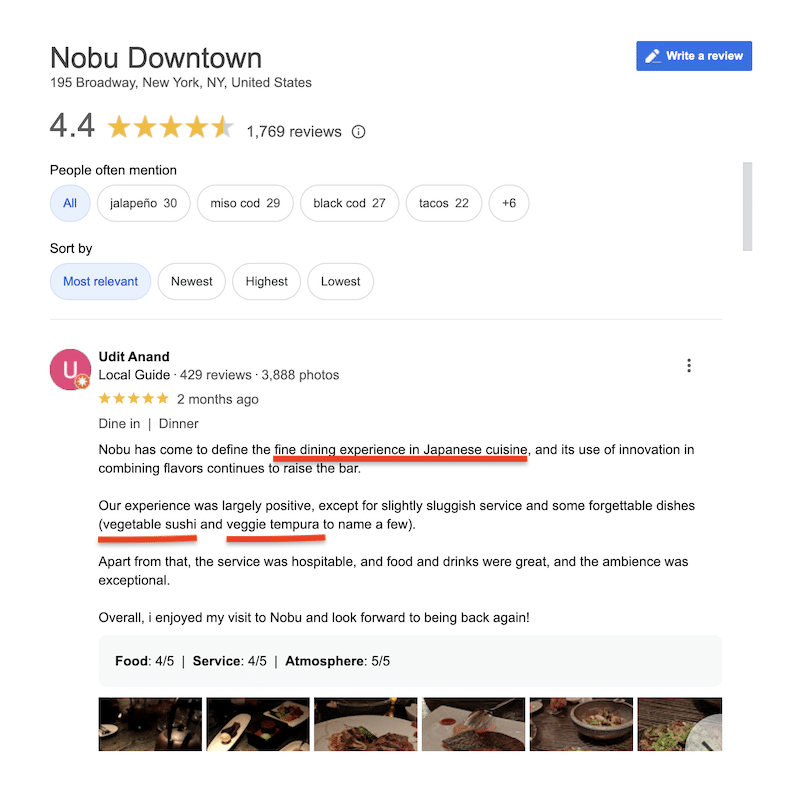
Since these keywords align with what people search for when looking for luxury Japanese dining in New York, Nobu Downtown naturally ranks high in Google search results and Google Maps listings for related terms.
- Positive online reviews lead to higher click-through rates (CTR):
This one is a given—positive reviews boost your star rating, making your listing stand out and compelling potential customers to click on your business in search results.
And more clicks tell Google your site is valuable, which can push your rankings even higher.
- Local SEO advantages:
Out of 149 factors that influence local search rankings, customer reviews rank as the third most important, carrying 17% of the weight in determining whether your business shows up in the coveted Google local pack.
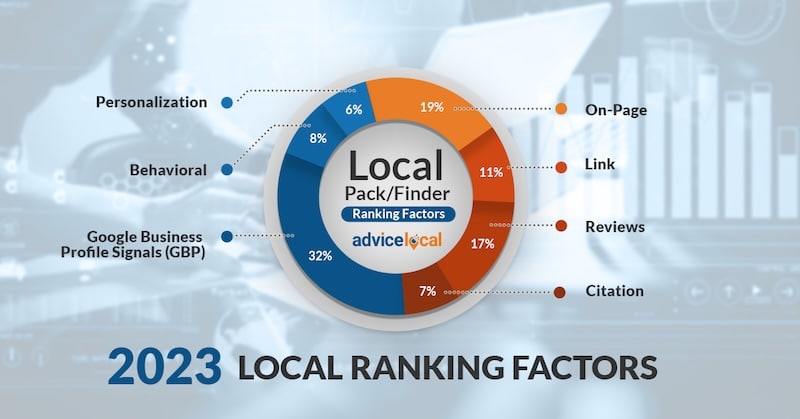
Think about it—Google wants you to show users the most relevant, trustworthy businesses. And what better way to gauge trust than honest feedback from customers? The more positive, detailed, and frequent your reviews, the more search engines see your business as credible and worth ranking higher.
Trust and brand reputation:
The concept of customer feedback influencing business reputation isn’t new. In ancient marketplaces, merchants relied on positive word-of-mouth to attract customers and sell their wares. Today, businesses rely on positive online reviews to attract more customers.
In fact, consumers are increasingly turning to Google reviews. In 2024, 81% of respondents said they use Google to find business reviews, up from 63% in 2020.
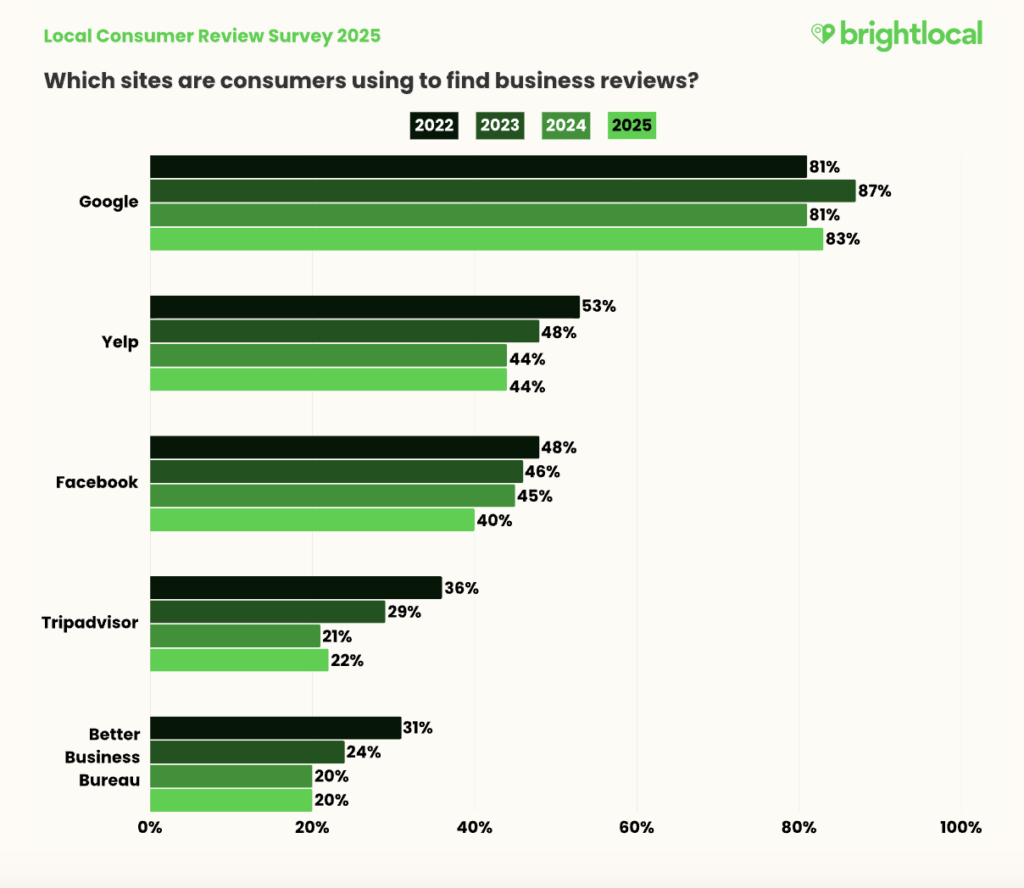
How to Collect Online Customer Reviews
We scoured the internet—Reddit discussions, expert opinions, and firsthand experiences—to uncover the most effective ways businesses collect online reviews.
The reality? Customers don’t leave reviews just because you ask. They need a nudge at the right time, with a frictionless process and a personal touch.
Here’s what works:
1. Make it effortless with QR codes and NFC cards
Most customers won’t leave a review unless you make it ridiculously easy. That’s why businesses now use QR codes and NFC tap cards to make the process quick and smooth.
Here’s how it works:
- QR codes: Place a QR code in-store, on receipts, or on product packaging, allowing your customers to leave a review instantly. A common (and effective) setup involves linking the QR code to:
- A Google Business review page for satisfied customers.
- A private feedback form if they’re dissatisfied—so complaints come directly to you instead of being posted publicly.
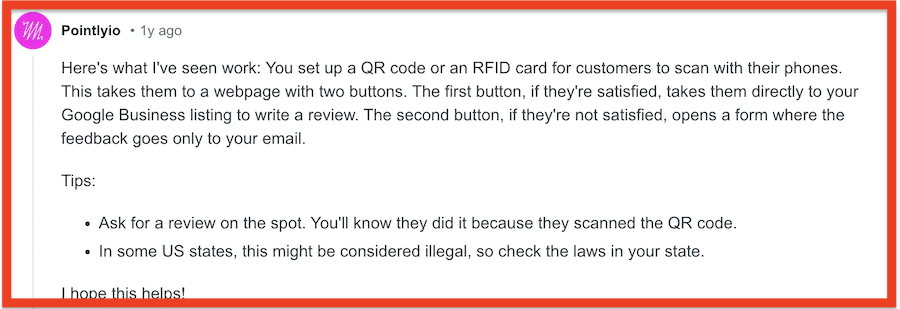
- NFC tap cards: Use services like GrowSEO that offer physical Google Review cards with NFC technology. Customers can simply tap their phones and be directed to leave a review. The fewer steps involved, the higher the chances they’ll follow through.
NFC tap cards functioning (Source)
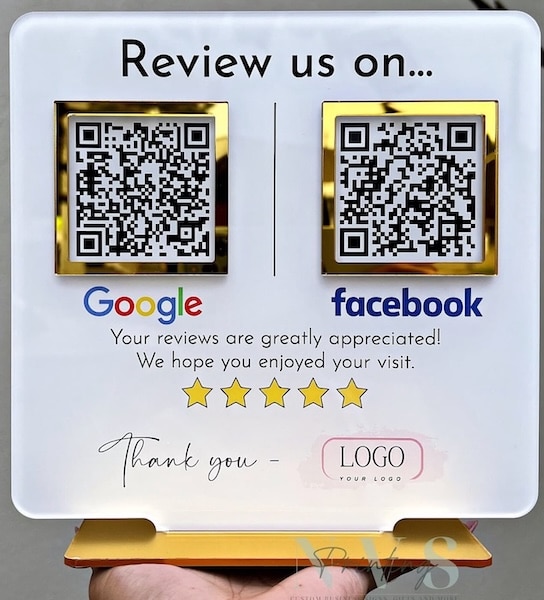
Note: In some U.S. states, directing only positive reviews to public platforms and negative ones to private channels might be considered deceptive. Always check local laws before implementing this approach.
2. Ask at the right time & make it personal
Timing is everything when it comes to collecting reviews. The moment of peak customer satisfaction is your best opportunity to ask—whether in person or via email.
- In-person asks: If you own a retail store, cafe, or service business, train employees to ask for a review right after a positive interaction. One Reddit user shared how they knew customers left a review immediately because they saw them scanning the QR code in real-time.
- Thoughtful follow-up emails: Instead of blasting out generic review requests, personalize them. Your approach should feel personal and sincere, not automated. Customers appreciate knowing their support matters. One business owner found success with a warm, genuine message:
“Thank you so much for supporting my small business! You have no idea how much it means to me. If you were happy with our product, leaving us a review here would mean the world: [Insert Link].”
- Ending customer interactions with a review request: If you’ve been emailing back and forth with a customer (resolving an issue, answering a question, etc.), don’t let the conversation end without asking for a review. A simple request can work wonders—something like:
“I’m so happy we could help! If you have a minute, would you mind leaving a quick review? It really helps small businesses like ours.”
3. Respond to reviews (especially the bad ones)
Most businesses focus on collecting reviews but forget the other side of the equation—how they respond to them. How a business handles reviews, especially negative ones, can influence future customers more than the reviews themselves.
Here’s how to go about it:
Always acknowledge issues professionally.
A bad review isn’t the end of the world if handled correctly. Respond with a calm, understanding tone to turn the negative experience into a positive one.
For example, let’s say a customer leaves a one-star review saying, “Terrible service! Waited 45 minutes for my food, and it was cold when it arrived.”
Don’t just say: “That’s not true. We were busy, and you should’ve been more patient.”
It comes off as defensive and dismissive of your customer’s experience and feelings.
You can turn this situation around by addressing it more positively. Say something like: We’re sorry for the delay and that your meal didn’t arrive as expected. We strive for better, and we’d love to make this right. Please contact [contact info], and we’ll do our best to fix this.”
This acknowledges the issue while remaining professional and offering a resolution.
Luxury hotels like Anantara Rome show how to handle negative reviews the right way. When a guest complained about a closed pool and a bad view, the hotel responded quickly, apologized sincerely, and explained that they could have offered a room change if informed earlier.
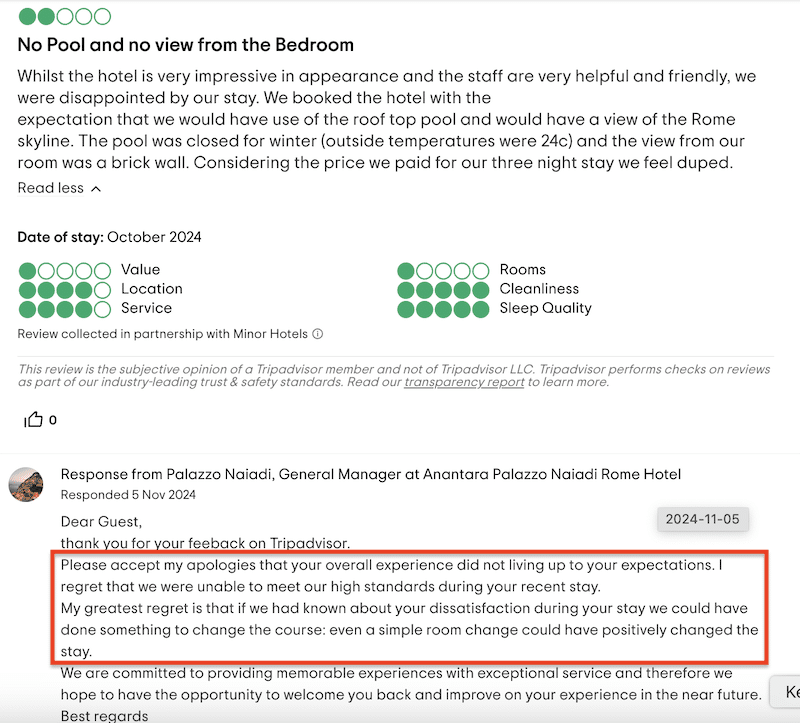
Instead of arguing, they remained polite, understanding, and solution-focused, showing the guest—and future customers—that they truly cared.
Don’t shy away from telling the whole story.
Some negative reviews lack context. If someone leaves a one-star review saying, “They refused to tow my car!”—a response like this can provide clarity:
“We’re so sorry we couldn’t accommodate you at that time! We were fully booked, and we never want to overpromise something we can’t deliver.”
This not only softens the impact of the review but also shows transparency.
Pro tip: Consumers trust businesses more when they see them handling criticism professionally. A well-worded response can do more for your reputation than a five-star review.
4. Avoid spammy or automated requests
Nobody likes being bombarded with generic review requests. Think about Amazon—how often do you delete their automated “Please leave a review” emails without opening them?
That’s precisely what you don’t want to happen with your business.
To get good reviews, make your request feel like a personal favor, not an obligation.
- Wait a few days before asking. Give customers time to use and enjoy your product to make your request feel more natural.
- Send a short, warm message. Say something like, “Thank you so much for your order! We’re a small business out of [City], and your support truly means everything to us. We’d love to hear about your experience if you have a moment! Here’s a quick link to leave a review.”
5. Offer a small incentive (the right way)
People love getting something in return for their time. But there’s a fine line between encouraging reviews and illegally “buying” them just to get more online reviews. Consumers trust online reviews and expect that the reviews on your website will be authentic and come from existing customers based on their actual experience with your brand.
Here’s how you can get more social proof the right way:
- Offer a token of appreciation—but for ALL reviews, not just positive ones. This is crucial for staying compliant with FTC guidelines. You can offer a small discount on a future purchase, a free sample, or even a simple thank-you note.
- Avoid conditional rewards: Instead of saying, “Leave a 5-star review for 10% off!” (which is unethical and could get you banned from review websites like Google and Yelp), say: “We appreciate every review, whether positive or constructive! As a thank-you for your time, here’s a small discount on your next order.”
This way, you’re encouraging honest feedback rather than artificially inflating ratings.
Infographic: Key Online Review Stats & Trends You Need to Know
We’ve got many more fun, interesting facts that’ll help you see why your customer review is so important to other shoppers! Check out our infographic, “The Importance Of Online Customer Reviews,” to read more facts. Enjoy!

Infographic by-Invesp conversion optimization
To Publish this Image on your Blog or Website. Copy this code
For nearly 9 in 10 consumers, an online review is as important as a personal recommendation.
Customers are likely to spend 31% more on a business with “excellent” reviews.
72% say that positive reviews make them trust a local business more
92% of users will use a local business if it has at least a 4-star rating
72% of consumers will take action only after reading a positive review
Reliability (27%), expertise (21%) & professionalism (18%) are the most important reputation traits for a local business
Estimated Number Of Online Reviews Customers Read Before Trusting A Business
| Estimated number of reviews | %age |
| 0 | 8% |
| 1 | 3% |
| 2-3 | 24% |
| 4-6 | 32% |
| 7-10 | 18% |
| 11-20 | 8% |
| 21-30 | 3% |
| 31-40 | 1% |
| 41-50 | 1% |
| 51+ | 2% |
86% of people will hesitate to purchase from a business that has negative online reviews.
On average, a one-star increase on Yelp leads to a 5 to 9% increase in a business’s revenue. At the same time, a single negative review can cost a business about 30 customers.
The number of reviews posted every minute by Yelp users is 26,380
The percentage of Yelp users that have made a purchase at a business they found on Yelp is 98%
The percentage of Yelp users that visit Yelp because they intend to make a purchase is 80%
How To Deal With Negative Reviews
When you receive a negative review, here’s what you should do:
- Respond Promptly
- Be real and admit your mistakes
- Correct inaccuracies
- Highlight your strengths
- Write like a person, not a corporation
- Take it offline
- Provide restitution if it’s warranted
- Ask loyal customers to share their experiences
- Be consistent
- Understand How Rating and Review Sites Work



